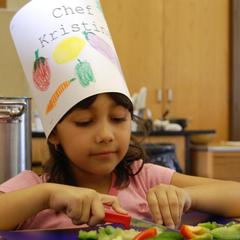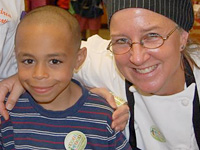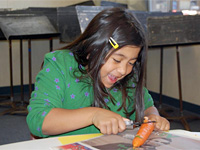Jr. Chef Day
Jr. Chef Day cooking events were an early technique we used to bring food-based education into the elementary school setting. These events created excitement and enthusiasm in the school community, taught young people about where food comes from, and, in a natural way, encouraged them to try new foods.
 Feeling connected to what we eat, through food-based education, cooking and gardening programs, and eating together in a communal setting, is integral to changing food preferences and attitudes towards food. This connection interrupts the momentum of the convenience-based, over-processed food that holds sway and contributes to chronic health issues for young people and adults. Through simple acts of cooking and growing food, we begin to reclaim the health and well-being of our children and of ourselves.
Feeling connected to what we eat, through food-based education, cooking and gardening programs, and eating together in a communal setting, is integral to changing food preferences and attitudes towards food. This connection interrupts the momentum of the convenience-based, over-processed food that holds sway and contributes to chronic health issues for young people and adults. Through simple acts of cooking and growing food, we begin to reclaim the health and well-being of our children and of ourselves.
During a Jr. Chef Day event, each and every child in the school played a role in preparing a meal. Recipes such as Winter Harvest Soup or Three-Bean Vegetable Chili contain diverse, fresh, and seasonal ingredients. The original recipe was scaled to meet the population size of the school, from serving 8 to serving up to 800. This conversion calculation was used as a math lesson with 5th grade students.

On each campus, a temporary kitchen was created for the day, and a team of parent volunteers supported students during the cooking experience. Each class got a 15 to 20 minute period in the kitchen to perform one aspect of the production. Perhaps first graders peeled carrots, fourth graders diced summer squash, and kindergartners tore kale, rosemary, and basil. The parent volunteers managed each table of Jr. Chef's, while the chef or teacher led the educational activity and oversaw the actual production of the larger recipe.

On day two of a Junior Chef event, this meal, created by the entire student body, was served. Each and every student, faculty member, and parent got the chance to share the aromatic and flavorful dish together. Many returned, asking for seconds or thirds, and by the end of lunch the communally-made creation had been completely consumed by its creators.

Peeling carrots, slicing zucchinis, or chopping tomatoes is not exactly the same as following every step in the production of a recipe, but for our young chefs these acts provided an enormous feeling of ownership over the final product. Just as watching lettuce grow from seed entices the grower to take a bite, seeing the bean you shelled the day before show up in your lunch can make you eager to try a taste. This event inevitably turned into the day that some students tried eggplant or kale or another fresh vegetable for the first time; into the day that others realized that carrots, onions, and garlic are roots that grow beneath the soil; into the day that still others marched home proudly to their parents, recipes in hand, determined to recreate for their families the delicious, energy-giving meal they shared with their friends at school. It is for all of these reasons that Jr. Chef day was such a powerful event for everyone involved, and so complementary to the changes that are being made in school kitchens around the county.




 Jr. Chef Day
Jr. Chef Day